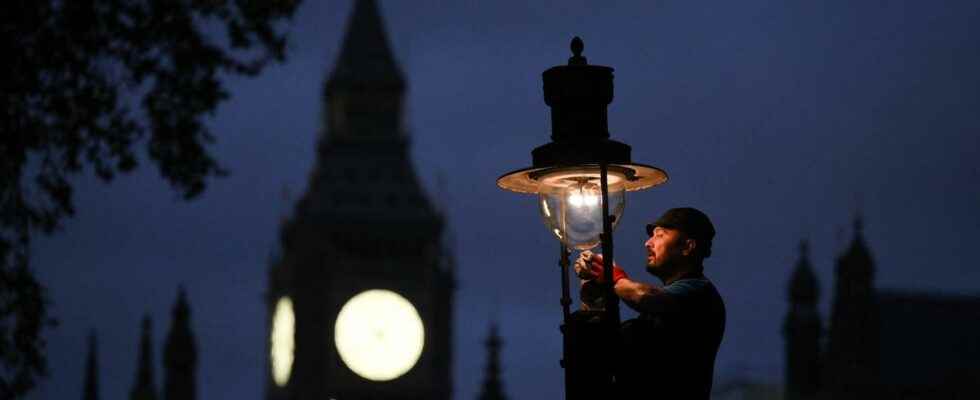Five “lighters” are still working in the streets of the capital to maintain these streetlights, the municipality of which has chosen to keep 174 of the thousand still in good condition.
In front of Westminster Abbey, under the intrigued gaze of tourists, Paul Doy climbs his ladder, raises the globe of a gas lamppost, winds the timer then ignites the small fabric sleeves which, by heating the metal, create the warm light so typical of these floor lamps. “I like the historical aspect of this worksays Paul, who gets up every morning at 5 a.m. to carry out his mission in the tourist district of Covent Garden. “It’s mainly about winding 100-year-old mechanical clocks and setting the timelighting the streetlights, says this member of a team of five streetlight lighters.
But this 200-year-old ritual almost disappeared from central London. In recent years, these old street lamps have tended to be replaced by more modern street lamps, powered by electricity. The borough of Westminster wanted to replace the nearly 300 gas streetlights that still exist in its area, to the chagrin of some residents and heritage lovers. Thanks to an intense mobilization, the latter succeeded in partially bending the municipality, which finally agreed this week to keep 174 of them, in particular those located in particularly “remarkable“, she said Tuesday in a press release announcing her decision.
Read alsoStéphane Bern opens the doors of his home to us in the Perche, in Thiron-Gardais
The subject had even been raised recently in Parliament, where deputies had taken the side of the old street lamps. A little over a year ago, Tim Bryars, owner of a small bookshop in Covent Garden and the originator of the campaign to save streetlights, discovered this project by chance. “One morning I came out of my shop, there were two men from town digging a hole. I asked them what they were doing and they said don’t worry, they were just looking to see if it would be easy to convert those gas lamps to electricity.“, he says. Today, he believes the city’s decision is “a satisfying first step“. “But she must do more. We need strong political commitment to actually preserve gas streetlights, not just keep a few until they become inconvenient“, he adds.
Rochester, Grosvenor models, simple or more refined design, London still has more than 1,000 of these gas street lamps, installed from the beginning of the 19th century and considered then as a major innovation in a city center with dark streets, often infamous and dangerous. In the heart of the capital, they still light up part of the Mall, the main avenue leading to Buckingham Palace, the small streets of Covent Garden or the surroundings of Westminster Abbey, recreating at nightfall the mysterious atmosphere of the novels of Charles Dickens or movies like Mary Poppins Where sherlock holmes.
When they are broken, the streets remain dark for longer and are no longer safe enough for pedestrians.
Paul Dilmodenberg, Member of the City Council
“They’re an incredibly important part of London’s history, they’re in its DNA.defends Luke Honey, an author specializing in antiquities involved in the campaign to save them, looking fondly at one of these lampposts in Goodwins Court, a side street in Covent Garden.
The authorities justified their project by safety reasons, their ambition to reduce CO2 emissions and the difficulty of maintaining these old streetlights. “When they are broken, the streets remain dark for longer and are no longer safe enough for pedestrians“, explained to AFP Paul Dilmodenberg, member of the municipal council, just before the opening of the public consultation. The municipality hoped to convince the recalcitrant that the models of led streetlights were “very good imitationsof those with gas.
Going electric
“Some look very pretty. But they are still different from the originals“However, believes Joe Fuller, head of the maintenance team for old street lamps at British Gas, judging that”it is essential that we preserve this heritage and that we keep as much of it as possible“. Of the nearly 300 street lamps threatened, 94 will be replaced by electric models whose lanterns will still be “improved to more closely reflect the details of the original ones“, in accordance with the remarks of the organizations of defense of the heritage, indicates the municipal council. Heritage advocates intend to verify the reasons for which they were chosen and still hope to save some, warns Tim Bryars.
SEE ALSO – London: Nurses begin second day of strike
